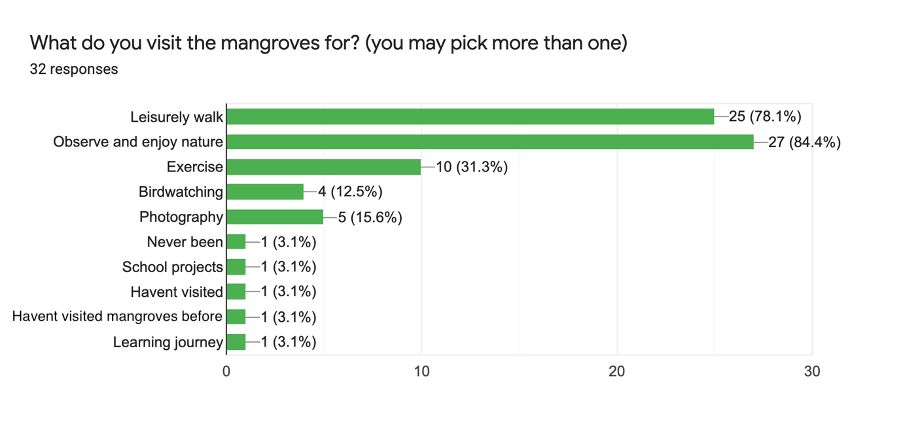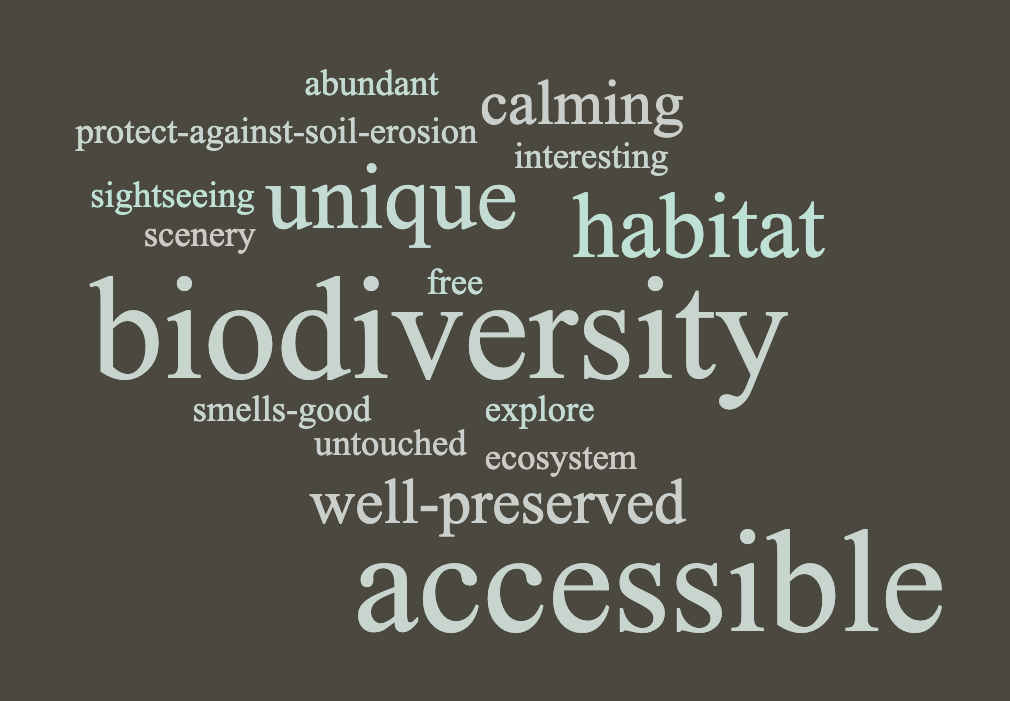Hello everyone! In this post, we’ll continue dissecting the responses gathered from the survey to see what insights we can find about the perceptions of Singaporeans towards our mangroves.

When asked about their purposes of visit to the mangroves, the top 2 responses were to take leisurely walks (78.1%) and to observe and enjoy nature (84.4%), activities of a more passive nature. Meanwhile, more deliberate activities such as exercise (31.3%), birdwatching (12.5%) and photography (15.6%) constituted a significantly lower proportion of the responses. It can hence be seen that people tend to take a more passive approach towards the appreciation of mangroves, or nature for that matter. There’s absolutely nothing wrong with that, in fact that’s what I love too. In my response to Amira’s comment in my previous post however, I mentioned that regular visitors probably visit mangroves for more deliberate activities like birdwatching and photography. In case of any confusion, I just want to clarify that this survey’s respondents comprise mainly irregular, ad-hoc visitors, hence the shown results.

Source: Google Forms
The responses to the above question also raised a noteworthy revelation. When asked which of the mangroves’ roles they feel are important, the respondents indicated “habitat for biodiversity” (93.8%) and “protection of shorelines against erosion” (81.3%) as the two most important roles. These are ecological and geomorphological roles respectively, essentially tangible, observable functions, tying in with the word cloud in my previous post where I highlighted that people’s mental images of mangroves comprised mainly the physical characteristics. On the other hand, the only 2 options which included socio-cultural aspects, namely “educational value for Singaporeans” (34.4%) and “recreational space for Singaporeans” (37.5%), were checked by the smallest number of respondents. Evidently, Singaporeans generally do not yet recognise the role of our mangroves in their daily lives, in terms of its social value.

Source: worditout.com

Source: worditout.com
The respondents were also asked to state what they liked most about our mangroves, as well as their biggest turn-off to visiting them. I generated the above word clouds by categorising the responses according to key words, with slight rephrasing for synonyms to achieve the same effect. As you can see, the 2 best things about our mangroves as indicated by our respondents were the biodiversity and accessibility of the mangroves. Meanwhile, the biggest turn-offs for them were that our mangroves are ulu (a local colloquial term meaning remote, deserted or inaccessible) and also mosquitoes. Wait, doesn’t accessibility contradict with the mangroves being ulu? In this case, I took accessibility to mean that the provision of trails and boardwalks allowed people to get as close as possible to the flora and fauna, while ulu would mean that the mangroves are located in remote places far away from most people, or as I like to call it, 鸟不生蛋的地方 (direct translation: where even birds don’t lay eggs).
In order to maximise the experience of visitors, we should capitalise on what they like most about our mangroves, while mitigating the turn-offs wherever possible. Unfortunately, location and presence of mosquitoes are things we cannot and should not control, hence the best we can do is to work on the positives. What does this mean? Simply put, we should conserve the mangrove ecosystems while working on improving biodiversity appreciation via education and exposure, while also building more trails and boardwalks if possible.
All this is a lot to take in, so I’ll summarise the key findings of the survey here:
- Our mangroves are under-explored, and are usually visited on special occasions only
- Most Singaporeans are curious and open-minded towards our mangroves, with a basic level of knowledge on the unique physical characteristics, and are generally eager to learn more
- People tend to appreciate mangroves in passive rather than active ways
- Most Singaporeans do not recognise the educational and recreational value of our mangroves
- Our mangroves’ best selling point is their biodiversity, while the biggest downside is their remote locations
In light of these findings, we can see the huge potential of more quality exposure to the mangroves for Singaporeans. This can take the form of guided mangrove nature walks, more attractive and informative displays along the boardwalks and trails, more school-led field trips etc. Essentially, we need to be able to help people to have eye-opening experiences on their few visits to the mangroves, in order to inspire in them a deeper appreciation and sense of wonder at this unique ecosystem. Only then would they be willing to travel the long distances to visit mangroves more often, to continue nurturing this newfound interest. For the point on passive appreciation, I personally think it’s a wonderful thing, but before people are able to appreciate mangroves on their own, some of them might first need to be guided.
Once again, thank you guys for all your responses, it has been hugely insightful for me! Do stay tuned for the rest of my blog. Cheers!